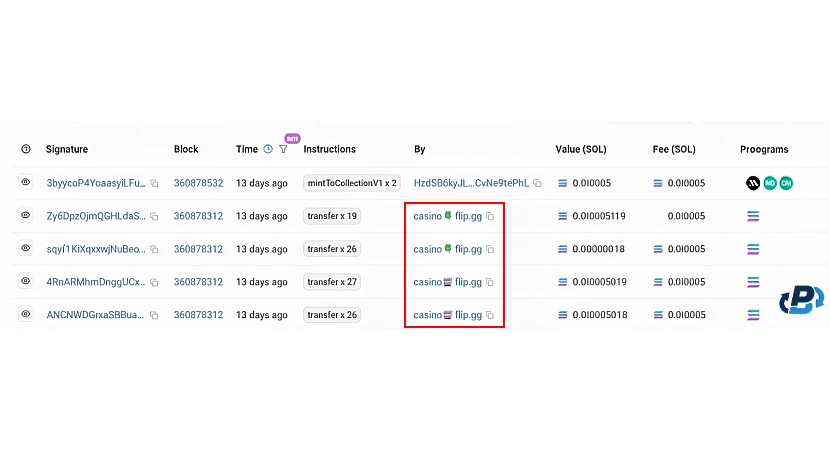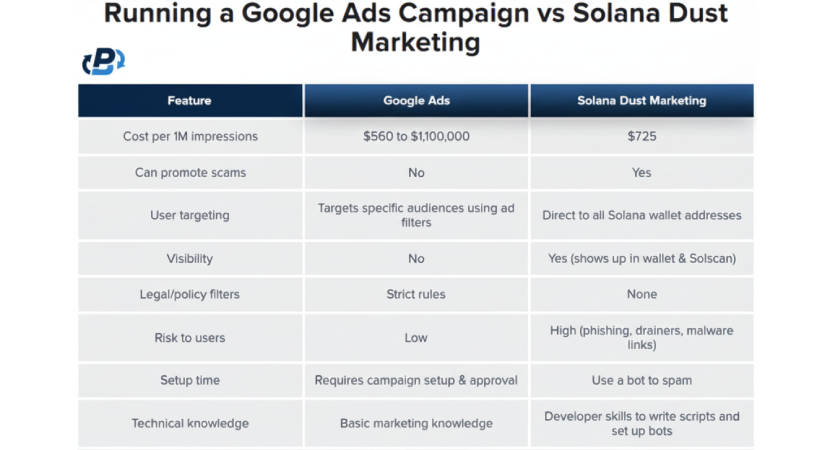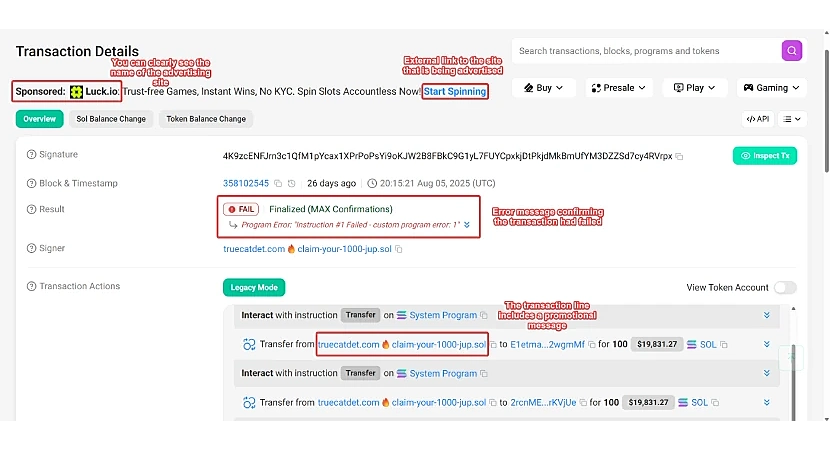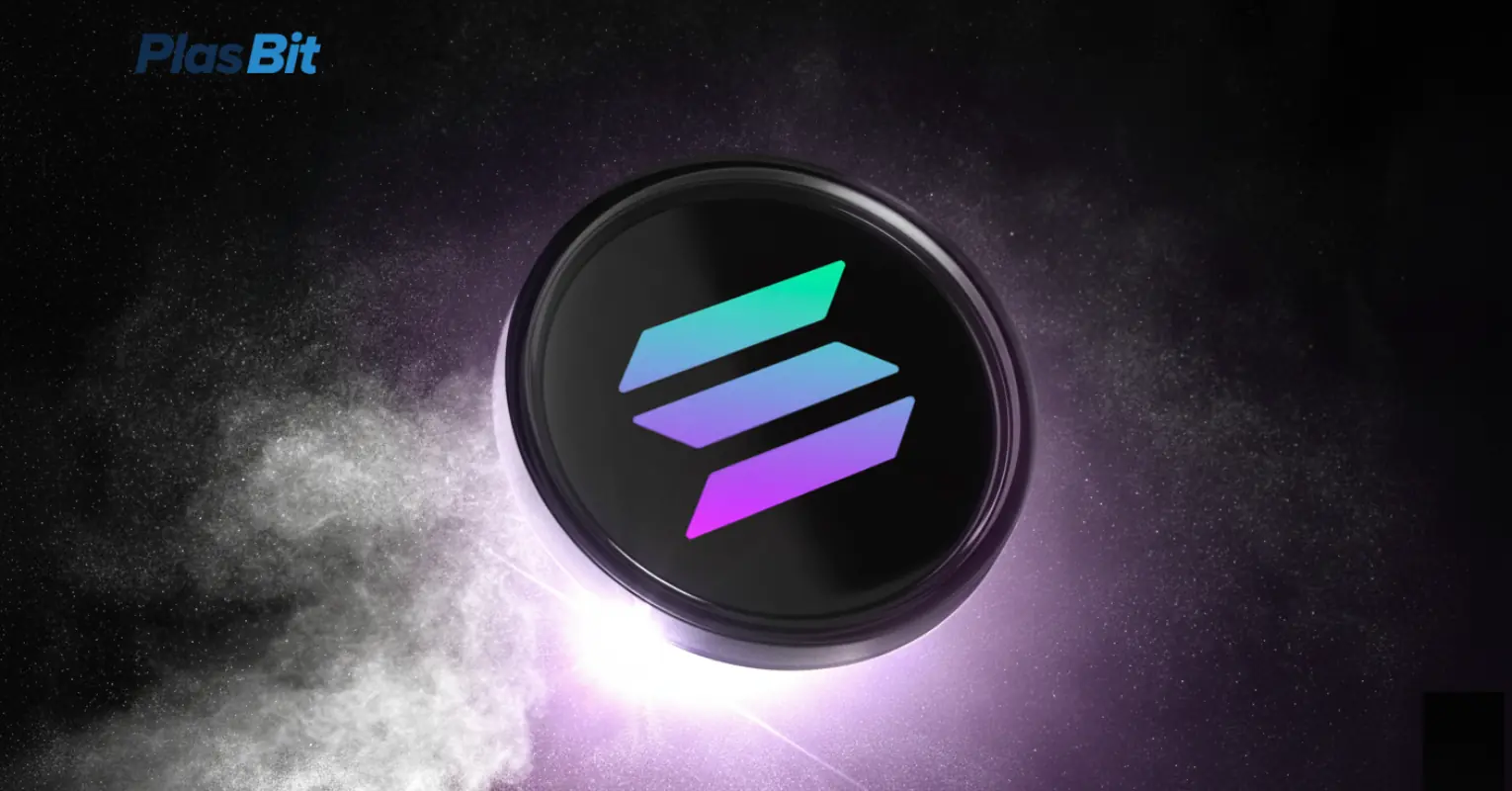In the crypto world, even the smallest transactions can carry big implications. What began as a malicious technique known as a dust attack has now evolved into a novel form of blockchain-based advertising (and spam). Before we go into details, you first need to know that a dust attack in crypto is a scam where an attacker sends a small amount of USDT to a victim’s wallet from an address crafted to mimic the start and end characters of one of the victim's previous transactions. The whole point is for the fake address to look familiar, so users will mistakenly copy the scammer’s address for a future payment and send funds to them. Recently, however, marketers have started exploiting the same mechanism on networks like Solana, turning these microtransactions into low-cost, attention-grabbing ads.
That begs the question of what is dust marketing in crypto? It’s a way to send spam transactions on the Solana network to random addresses by only paying the transaction fee and without actually sending any SOL. These transactions then appear in a user’s transfer history, with the sender’s domain (SNS) showing up as an advertisement. The amount sent is higher than the balance in the sender’s wallet, which makes the transaction fail while still paying only the transaction fee. This method is supposed to generate far more “views” and exposure compared to traditional paid advertising on other platforms, such as Google Ads, and is mostly used by casinos and scam websites.
How Dust Marketing Works
Dust marketing takes advantage of the way blockchain networks record transactions (even failed ones) on the public ledger. The process usually starts when advertisers or promoters collect a large list of wallet addresses, which can easily be obtained from on-chain data. Using a script, they send a transaction to each of these addresses, embedding a message, link, or brand name in the sender’s domain field (also known as the SNS, or Solana Name Service). This is where things get interesting and dust marketing comes into play. Instead of actually sending funds, the advertiser sets the transaction amount higher than the balance available in their wallet, making sure that the transfer will fail.
Despite not going through, the failed transaction, along with the sender’s information, still becomes visible in the recipient’s transaction history. Since many users often check their transaction history, the unwanted message or link becomes almost impossible to ignore. This approach lets marketers reach thousands or even millions of wallet owners directly, all for the cost of minimal network fees. Because transactions on Solana are so cheap, the price tag of this form of advertising is negligible, especially if you know what is dust marketing in crypto.

An example of how the dust marketing transactions appear in the transaction history
Why Dust Marketing Takes Place on Solana
Now that you know what is dust marketing in crypto, one of the main reasons dust marketing has gained traction on Solana in the first place is because of the platform’s exceptionally low transaction fees. Unlike Ethereum or Bitcoin, where sending thousands of microtransactions would be costly, Solana’s average transaction cost is a fraction of a cent. This makes it possible for users (or projects) to send large volumes of tiny transfers to thousands of wallet addresses at a marginal expense. From a marketing perspective, this notably improves the return on investment (ROI), which allows campaigns to reach a wide audience directly on-chain without the need for traditional ad spending or even paying someone like an influencer to spread the word about their project. We at PlasBit made a table to make things clearer for you and to show you how cheap dust marketing on Solana really is.

How does Solana dust marketing compare to Google Ads?
When it comes to advertising expenses, Solana dust marketing is dramatically cheaper than traditional methods. While Google Ads can cost anywhere between $560 and $1,100,000 per million impressions (depending on industry competition and targeting settings), dust marketing on Solana can achieve the same level of reach for as little as $725.

For targeting, Google Ads lets advertisers target specific groups of people based on what they like, who they are, or where they are located. Dust marketing on Solana works very differently, as it targets all Solana wallet addresses directly. There's no filtering to find the right audience, meaning everyone gets the same spammy transaction. The entire goal of this method is to achieve volume at the expense of precision and message relevance.
Visibility is one area where dust marketing has a unique advantage, since ads delivered through Google are shown within the platform’s ecosystem (web pages, search results, or even YouTube) and can be ignored or blocked. With dust marketing, messages on Solana appear directly in a user’s wallet history or on blockchain explorers such as Solscan. Plus, as we’ve mentioned earlier, because you often need to check your transaction history, you can't escape seeing these promotions.
Another difference is the policy and legal oversight, where Google Ads advertisers must follow strict rules about what they can advertise and how they present it. Campaigns undergo review, and violations can lead to suspension or bans. On the other hand, Solana dust marketing has no such rules. There are no centralized moderators or approval systems, and anyone can send promotional messages directly to wallets, regardless of the content.
The lack of oversight is what makes it attractive to some advertisers who can't use Google Ads to promote casinos or gambling websites, making this method wide open for scams and spam. That brings us to what is likely the biggest and most important difference, namely the scam risk. While Google Ads has content moderation and rules to stop scammers, anyone can use dust marketing on Solana to send malicious links. Because the sender can include a link or domain name in the transaction details, scammers often use this to promote phishing websites, wallet drainers, or malware downloads.
- Phishing scams typically trick users into clicking a link that leads to a fake version of a legitimate website, such as a fake crypto wallet interface or DeFi platform. In case the victim enters their seed phrase or private key, attackers immediately drain the funds.
- Wallet drainers often work in one of two ways, either tricking you into approving a fake transaction that secretly lets a scammer take your tokens or using fake websites to steal your password-like recovery phrase. As soon as you approve the transaction or provide your phrase, the scammer can quickly drain your wallet.
Time is one more factor worth mentioning, as setting up a Google Ads campaign can be lengthy in some cases. You have to configure keywords, ad groups, visuals, target audiences, budgets, and wait for a review process before the ads go live. In contrast, dust marketing on Solana can be launched almost instantly using automated scripts or bots. Once the target wallet list is collected and the bot is configured to send transactions, the campaign can be executed within minutes.
Finally, both vary in terms of technical knowledge, considering Google Ads calls for basic marketing know-how and dust marketing leans more on the technical side of things. For instance, developer skills are required to write scripts and automate thousands of transaction attempts via bots. In the end, compared to Google Ads, Solana dust marketing is a cheap and highly visible way to get a message in front of a huge audience.
How do crypto projects promote via dust transactions?
As you may have gathered by now, there’s a lot of spam with dust marketing. Because of it, the method has a bad reputation due to the potential for scams, but how do crypto projects promote via dust transactions? They send spam transactions to random wallet addresses on the Solana network, without actually sending any SOL, and by only paying the transaction fee.
These transactions then show up in a user’s transfer history, with a promotional text, ad, or link in place of the sender's domain name, and because the amounts they send are larger than what they have in their wallets, the transfers fail, and they only pay the transaction fee. This method is supposed to generate more views than traditional paid ads on platforms like Google Ads, and it is mostly used by casino and scam websites.
How to run your ad campaign with dust marketing
With knowing what is dust marketing in crypto, we’ll now switch to a practical side with a step-by-step guide (tested by our PlasBit team) on running your ad campaign by using a Windows computer.
1. Install WSL (Windows Subsystem for Linux), which also installs Ubuntu.
2. Open your WSL terminal and run the following command to install the Solana CLI:
sh -c "$(curl -sSfL https://release.anza.xyz/stable/install)"
3. After it finishes, reload your shell so the solana command works:
export PATH="/home/ubuntu/.local/share/solana/install/active_release/bin:$PATH"
4. Check that everything is working by running the following command:
solana --version
If successful, you should see something like - solana-cli 1.18.22 (src:xxxx; feat:xxxx)
5. Run the following command to generate a new pair of Solana keys (new private and public address):
solana-keygen new
6. Switch to Mainnet by running the next command:
solana config set --url https://api.mainnet-beta.solana.com
7. Make sure you have a wallet with a tiny balance — just enough to pay the fee (≈0.000005 SOL). For safety, use a small test wallet, not your main funds.
8. Get the recipient address, it can be any Solana address, even one of your own (for testing purposes).
Example: 11111111111111111111111111111111 (System Program ID).
9. Run a transfer command with way more SOL than you own, using the next command (Suppose your wallet has 0.001 SOL, try to “send” 100 SOL):
solana transfer 11111111111111111111111111111111 100 --from ~/.config/solana/id.json --allow-unfunded-recipient --skip-preflight
Note: "--skip-preflight" is important: it forces the transaction to land on the chain even though it will fail.
10. Now the transaction should get confirmed, and the log will show:
Instruction #1 Failed: custom program error: 0x1
Note: You paid only the transaction fee, no SOL was actually moved.
11. Verify that it worked - copy the transaction signature the CLI gives you.
Go to a Solana Explorer (Solscan.io, for example) and search the transaction using the signature; its status should be "Failed" with an error code. The image below is an example of how it should look like:

Transaction details on Solana Explorer
That’s all you need to reproduce the exact pattern (fee burned, insufficient funds, instruction #1 fail) for testing your patching logic.
Extra network load with dust marketing
The thing with dust marketing is that each transaction attempt, even when it fails, uses up resources on the network. This includes the work done by the servers that process the request, the systems that verify it, and the tools people use to look up transaction history. In a nutshell, standard users end up suffering because the computers that run the network, the services that read it, and the users’ wallets all have to deal with a huge flood of extra work. All of that translates to more expensive and slower transactions for everyone, regardless of whether they’re actually doing dust marketing or not.
The reason why fees go up in this situation is because validators, RPC providers, block explorers, and wallets are all required to process and index a notably higher number of messages. That increased demand competes with legitimate activity and pushes up the effective cost of using the network for all users. As a result, the companies providing data services might start charging more or slowing down requests to handle the extra load.
Beyond fees, the constant spam ruins the user experience as the transaction history gets filled with junk, making it hard to find your real transactions. Additionally, this isn’t just annoying, but dangerous since real phishing attacks can hide among the spam, making it more likely that someone will accidentally click a malicious link and lose their funds.
Why do I see all these spam advertisements on my Solana transaction history?
If you’re on the receiving end of dust transactions, more often than not, there will be a huge amount of these unwanted messages in your transaction history on Solana. Hence, it’s perfectly reasonable to ask yourself why do I see all these spam advertisements on my Solana transaction history? Because scammers and advertisers abuse Solana's low fees to send spam transactions to random wallet addresses, without sending any actual SOL, and only paying the transaction fee. These transactions then appear in your transfer history, where the sender’s SNS name is displayed like a promotional link.
Since they send more SOL than they have in their wallet, the transaction fails, but only the network fee is charged. This delivers more exposure than standard paid ads, like Google Ads, and is commonly used by scam sites and shady casinos.
Why am I getting Solana spam transactions?
Now that you’re well-versed in dust marketing and Solana, you might be thinking why am I getting Solana spam transactions? Advertisers use the network's low to send spam transactions to random wallets, while only paying the transaction fee and without actually sending any SOL. These transactions then appear in a user’s history, where the sender’s domain shows as promotional text.
Since the amount sent is higher than the sender’s balance, the transaction fails, while only the fee is paid. It is marketed as more effective than paid advertising, such as Google Ads, and is primarily used by casinos and wallet drainer sites.
Dust marketing on Solana is still relatively unknown
After examining what is dust marketing in crypto, it remains a relatively new and little-known tactic on Solana for now. Only a small number of advertisers (or “advertisers”, more like it) and users have discovered and started experimenting with it, which means the network isn’t yet feeling its full impact (fortunately). Nevertheless, as word spreads about how cheap and effective this method is, it’s likely that both legitimate promoters and scammers will begin to use it more aggressively.
If that happens, the Solana network could face a wave of constant spam, with millions of tiny transactions clogging the system, raising fees, and making transaction histories increasingly annoying and unsafe to navigate. For everyday users, this means staying alert to unknown or suspicious entries in their wallets and avoiding any embedded links or messages that appear in their transaction lists.
Dust marketing might look like a smart trick right now, but if you think about it, it's more of a loophole that makes the network worse for everyone. As awareness grows, developers and platforms will almost certainly take steps to limit or block it. Until then, you should remain cautious and informed about this evolving practice, and we at PlasBit hope we did our part in educating you and the rest of our readers.








